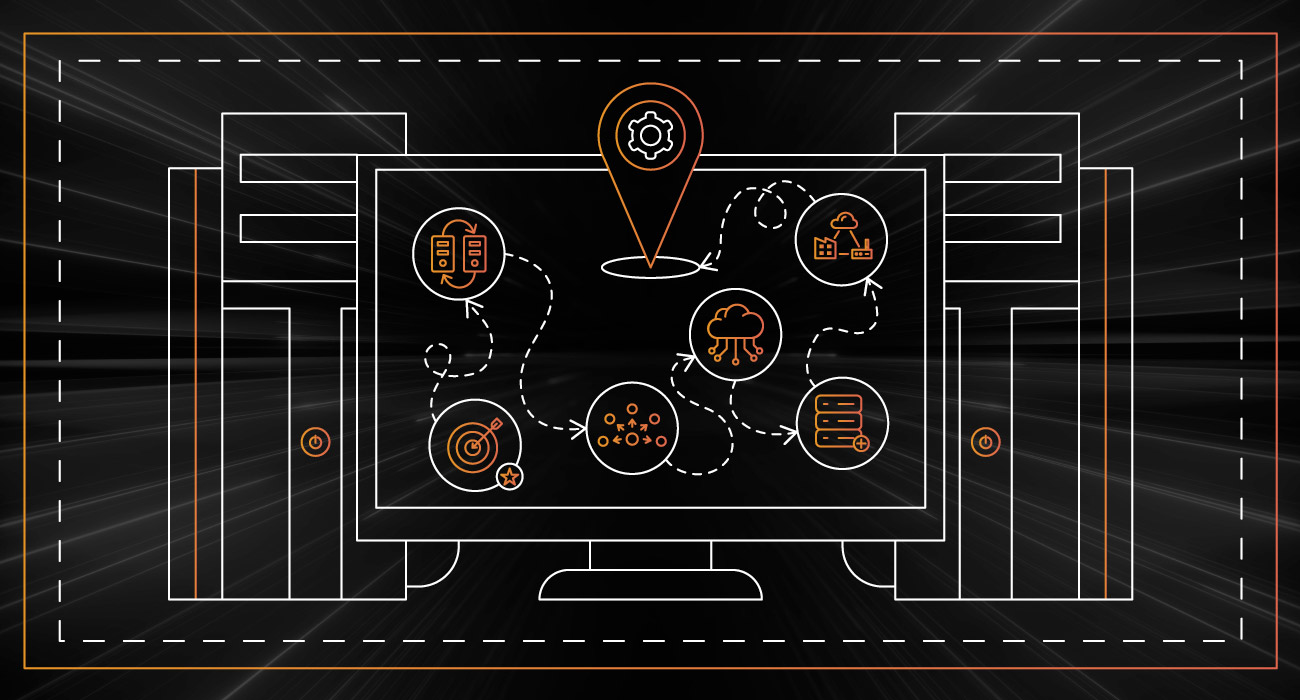Creating A Digital Transformation Roadmap Using A Unified Namespace

Digital Transformation has become one of the most popular buzzwords in the automation industry, often used to describe any digital improvements to industrial technology. But what really is Digital Transformation, and how can your organization achieve it?
The definition of Digital Transformation from the ARC Advisory Group is “the transformation of industrial products, operations, value chains, and aftermarket services that are enabled through the augmentation of people and knowledge through the expanded use of sensors, data, and analytics.” In other words, it’s more than just a technological upgrade; it requires a cultural shift that encourages organizations to continually challenge the status quo, innovate, and get comfortable with the quickly changing automation landscape.
By taking a step-by-step approach, businesses can modernize incrementally, improving efficiency, scalability, and data accessibility along the way. One of the best ways to do this is by creating an accessible single source of truth for data, or a Unified Namespace (UNS). This blog will outline the essential steps to developing and executing a Digital Transformation roadmap with a UNS that thrives in the digital age.

The Benefits Of Digital Transformation
Digital Transformation is essential for businesses aiming to compete in today’s technology-driven market because it significantly enhances efficiency and streamlines operations by reducing manual work through automation and making data more accessible.
Traditionally, control systems were built with human machine interfaces (HMI) communicating directly with PLCs, proprietary supervisory control and data acquisition (SCADA) systems with middleware, a proprietary historian, and a limited number of licensed clients and tags. This limits your scalability and leads to higher expenses, more downtime, and a steeper learning curve when you finally upgrade your system.
Digital Transformation empowers businesses to improve customer experiences by leveraging edge and cloud technologies, data analytics, and emerging technologies like AI, ML, and predictive maintenance, which allows you to offer personalized services that meet modern consumer expectations. It also facilitates data-driven decision-making, providing insights into your enterprise and giving you the ability to grow and adapt to changes in the future without proportional increases in costs.
Digital Transformation also includes bridging the gap between OT and IT systems, which helps you improve interoperability, increase collaboration across various departments, break down data silos, and boost overall productivity.
Ultimately, embracing Digital Transformation not only enhances operational efficiency and customer engagement but also positions your organization for sustainable growth and innovation in an increasingly digital world.

Step 1: Setting A Vision And Goals For Your Digital Transformation Roadmap
A very common obstacle to Digital Transformation is changing entrenched systems, such as proprietary software and siloed OT and IT environments. Digital Transformation is a continuous process, so to ensure it works, your OT and IT managers need to be on board with it. This often means a shift in your organization’s culture and vision.
Another common obstacle is balancing accessibility and security. To achieve Digital Transformation, your enterprise will need access to OT data, and younger workers often prefer using mobile devices, so you need a robust OT system with strong security and connectivity to open-source IT protocols. Also, tools like two-factor authentication and single sign-on ensure that only authorized users can access critical data.
To guarantee your vision encompasses the diverse perspectives and needs across your organization, you should involve members from across departments and look at competitors in your industry. This allows you to derive actionable and measurable goals that focus on areas like improving customer experience, data accessibility, or enhancing operational efficiency.
Lastly, you should develop a detailed implementation plan that includes timelines and resource allocations based on your needs.

Step 2: Parallel Integration With Existing Systems
One of the biggest misconceptions about Digital Transformation is that you need to rip and replace legacy systems. Instead of replacing your legacy infrastructure, adding a modern automation system in parallel allows for a gradual transition while still maintaining current operations.
To deploy a system in parallel with your existing system, you will need a platform that can digitize your operations, providing tools for data collection, visualization, reporting, and alarming, all in one centralized location. It should also be cross-platform compatible so that you aren’t locked into a specific operating system. This parallel deployment ensures that you can start solving immediate challenges, like removing manual work and improving data access, without disrupting operations.

Step 3: Leverage MQTT For Data Transmission And A Unified Namespace
You will need a capable messaging protocol to send data from all of your devices and systems to one place. MQTT is a lightweight, bidirectional messaging protocol that allows devices to publish and subscribe to data in real time. Originally designed for the oil & gas industry to improve bandwidth usage, MQTT has now become a dominant protocol for the Industrial Internet of Things (IIoT) and for building UNS.
MQTT is one of the most useful technologies for Digital Transformation because it can reduce your bandwidth consumption by up to 90 percent. It also decouples your devices from your applications and connects them to your infrastructure, reducing connection and downtime issues and pushing polling closer to your devices.
These capabilities enable you to create a UNS, which acts as the foundation of your Digital Transformation initiatives. It consists of your automation platform, a cloud platform like Snowflake, an MQTT broker, and all of your connected devices. In a UNS, data from your SCADA, manufacturing execution system (MES), enterprise resource planning (ERP), smart devices, and more are organized into a fully accessible, secure, and organized architecture that captures, processes, and responds to events from decoupled devices and systems.

Step 4: Implement Edge Computing
If your system needs to control and communicate with remote sites, you will also need an edge platform that seamlessly integrates with your central system. The system should have as few limits as possible for adding tags and device connections so you can easily scale your data collection power by adding new PLCs and sensors to your equipment.
Edge computing allows your system to process data at the edge of the network, closer to the devices generating the data. This step is essential for managing vast amounts of information coming from distributed locations, especially in industries that rely on remote PLCs and sensors. By processing data locally, businesses can reduce latency, improve data accuracy, and ensure that critical information is available in real time.

Step 5: Add New Devices And Sensors
While modernizing existing systems is important, it’s also essential to capture data from previously inaccessible areas. Step five involves integrating new devices and sensors to expand data-collection capabilities. This is particularly relevant in cases where older infrastructure lacks sufficient sensors or where you are manually collecting data.
New IoT-enabled devices can be added to the infrastructure, enabling more granular monitoring and control. Devices like Opto 22’s groov RIO offer nearly infinite configurability, allowing businesses to monitor various parameters such as temperature, pressure, and equipment performance. With MQTT Sparkplug built into these devices, organizations can seamlessly integrate new data points into their architecture, further enriching their data ecosystem.
By bringing more devices and sensors into the mix, organizations can start to access valuable data that was previously siloed or overlooked, enabling more accurate decision-making and operational optimization.

Step 6: Leverage The Cloud For Scalability And Advanced Analytics
The final step in this Digital Transformation roadmap is to take advantage of cloud computing. The cloud offers virtually unlimited storage and computational power, making it an ideal platform for running advanced analytics, machine learning models, and business intelligence tools. However, transitioning to the cloud can be a challenge, especially for organizations that are unfamiliar with cloud infrastructure.
Once data is in the cloud, organizations can begin to explore higher-level capabilities and technologies like predictive maintenance, process optimization, and AI-driven insights. By combining the power of cloud computing with the real-time data generated by Ignition and edge devices, businesses can unlock new levels of efficiency and innovation.

Create Your Enterprise Digital Transformation Roadmap And Unified Namespace With Ignition
Digital Transformation doesn’t have to be overwhelming. The key to creating a Digital Transformation roadmap for manufacturing, food and beverage, or any other industry lies in adopting an open, flexible, and collaborative approach — one that bridges the gap between OT and IT and empowers teams with the data they need to thrive in today’s fast-paced industrial environment.
By following this six-step roadmap for Digital Transformation and leveraging Inductive Automation’s open-source, web-based platform Ignition with Cirrus Link Solutions’ MQTT modules, you can create a UNS and streamline your Digital Transformation. Ignition is a platform for SCADA, HMI, MES, ERP, and IIoT that can be customized to match your processes on-premise, at the edge, or in the cloud.
Also, Ignition offers a free trial, and it has unlimited tags, clients, connections, and designers, so you can scale infinitely and prepare your system for future innovations.
Inductive Automation also provides free Ignition education through Inductive University, and it partners with a vast community of Digital Transformation experts from around the world that you can connect with through the Find an Integrator page or on the Ignition Forum.
